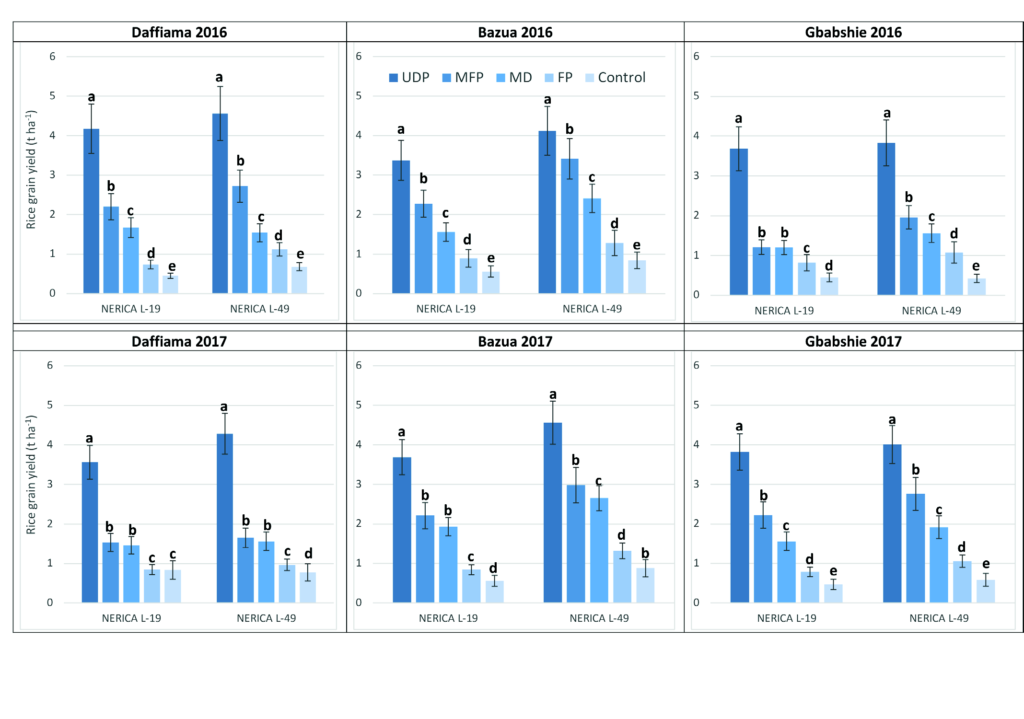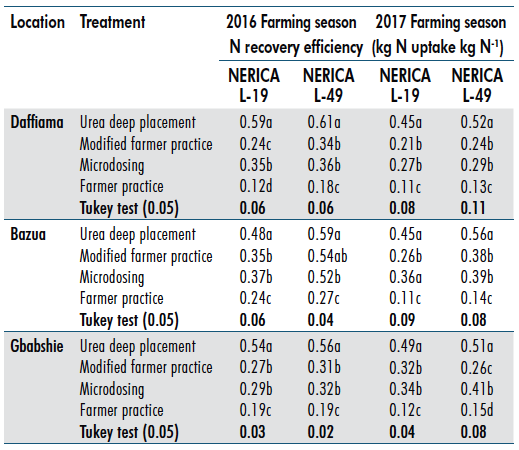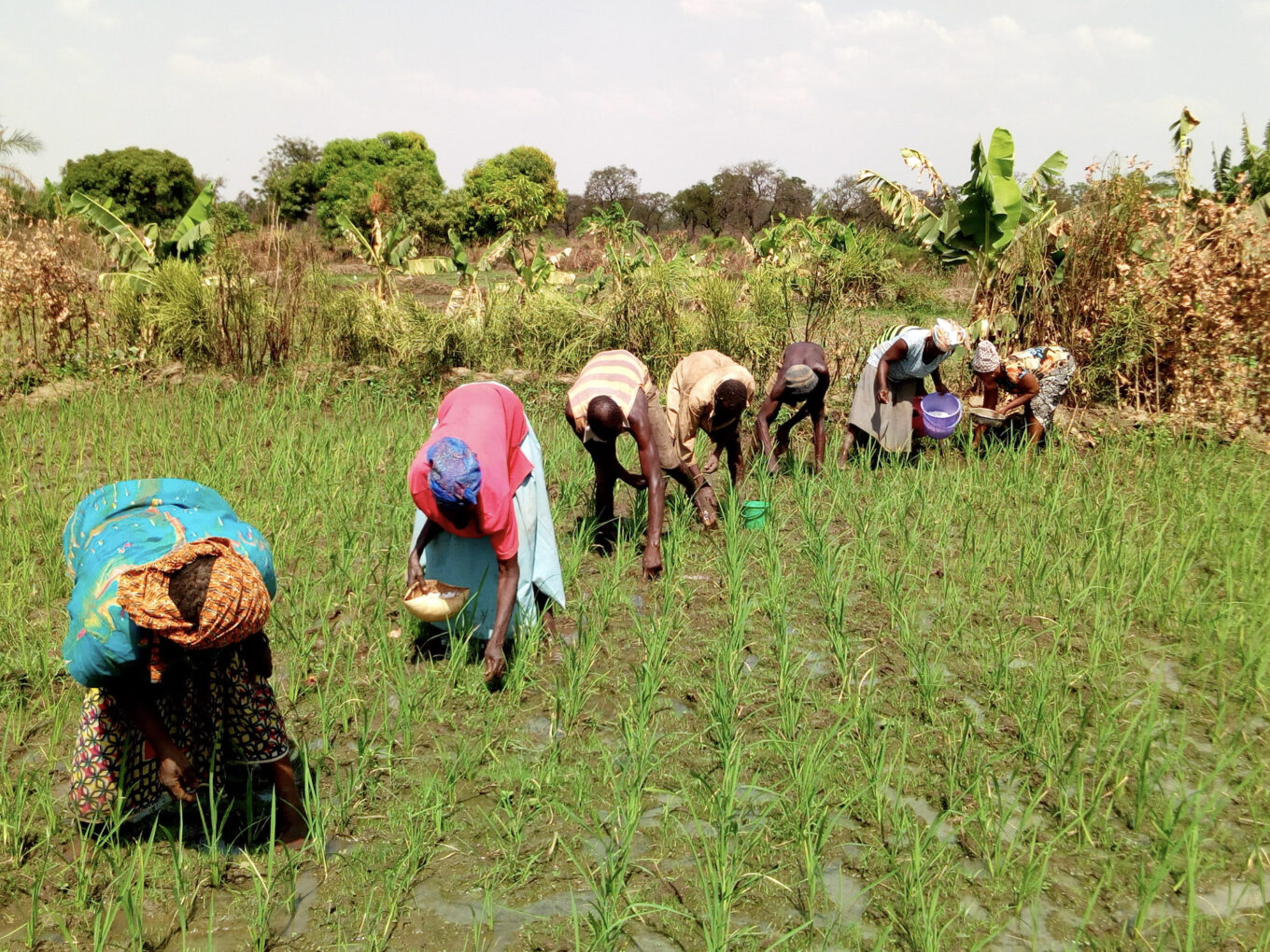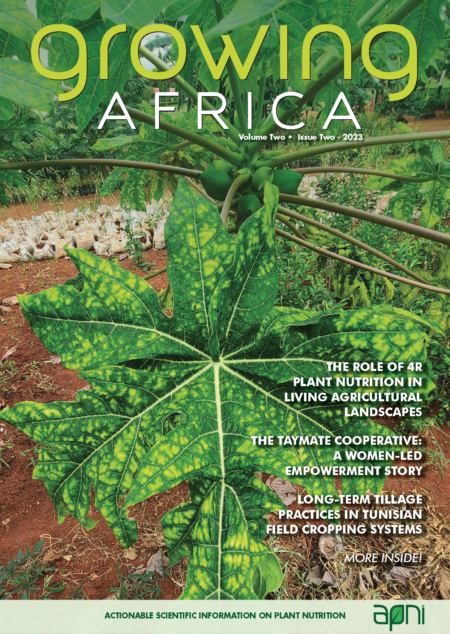By Sampson Agyin-Birikorang, Upendra Singh, Ignatius Tindjina, Alhaji Abdul-Rahman Issahaku, Haruna Waku Dauda, and Cisse Boubakary
Previous efforts to mitigate the negative impacts of submergence on rice production have focused mainly on varietal improvement. Synergistic effects of submergence-tolerant rice varieties and appropriate fertilizer management strategies are critical to enhance resilience of rice to submergence.
Rice is an important staple crop in SSA, and ensuring adequate availability throughout the year is critical for regional food security. However, in the face of climate variability, it will be difficult for countries in this region to achieve self-sufficiency in rice production. Globally, more than 16% of rice-producing lowlands are adversely affected by excess water stress, caused by either flash floods with complete submergence for a relatively short duration (commonly ranging from a few days to few weeks), or longer-term stagnant flooding of 20-50 cm water depth through most of the season (Asubonteng et al., 2001). Although rice is well known for its ability to grow in flooded soils, most rice cultivars cannot survive under submergence for more than a week, often resulting in total crop loss (Ismail et al., 2013). Efforts to improve rice productivity under such conditions have mainly focused on varietal improvement, which have resulted in breeding of several high yielding submergence-tolerance rice cultivars (Africa Rice Center, 2004). However, to achieve optimum production levels of these rice cultivars, there is the need to maximize the benefits for the genotypes with nutrient management strategies tailored for the specific environmental conditions. Optimal nutrition of rice seedlings before submergence and post-submergence is necessary for rice plants to fully develop cellular and metabolic requirements essential for surviving short-term submergence. Therefore, the objective of the study was to determine the most effective fertilization strategy that enhance rice production resilience in submergence-prone areas.
Field trial description
The trials were conducted during the 2016 and 2017 growing seasons in three flood-prone communities within the Guinea- and Sudan-savanna ecological zones of northern Ghana: (i) Daffiama (10° 51’ 0” N, 2° 45’ 0” W) and (ii) Bazua (11° 1’ 0” N, 0° 24’ 0” W) in the Sudan-savanna agroecological zone, (iii) Gbabshie (9° 5’ 0” N, 1° 49’ 0” W) in the Guinea savanna agro-ecological zone (Fig. 1).

Figure 1. Map showing the locations of the study sites within the Sudan-and Guinea savanna agro-ecological zones of Ghana. From: Rhebergen et al., 2016.
The experiment was laid in a split plot design with rice variety as the main plot and fertilizer treatments as the second subplot factor. The main plot and subplot treatments were completely randomized. The treatments comprised of two submergence-tolerant rice varieties (NERICA L19 and NERICA L49), and five fertilization strategies, including: (i) Farmer Practice (FP), where recommended rates of granular fertilizer was surface broadcast, (ii) Modified Farmer Practice (MFP), where recommended rates of granular fertilizers were incorporated into the soil at 7-10 cm deep, (iii) Urea Deep Placement (UDP), a technology with placement of urea supergranules (USG) 7-10 cm deep, (iv) Microdosing (MD) where small quantities of fertilizer are strategically placed directly in the rhizosphere, and (v) a control where no fertilizer was applied.
To prevent spread of water and fertilizer between plots, 50 cm wide levees were constructed around each plot, which were separated by 3 m alleys. Twenty-one-day old rice seedlings were manually transplanted into the puddled soils in 20 cm x 20 cm geometry. Except for the control, a recommended rate of 60 kg P ha-1 and 25 kg K ha-1 were applied to all plots at transplanting as basal fertilizer in the form of triple superphosphate (TSP) and muriate of potash (MOP), respectively, together with 5 kg Zn ha-1 (as zinc sulfate), 20 kg S ha-1 (as zinc sulfate and ammonium sulfate) and 40 kg N ha-1 (as ammonium sulfate and urea). For the MD treatment, basal fertilizers were placed directly in the transplanting hole following the procedure of Vandamme et al. (2018). The MFP and UDP treatments had basal fertilizers uniformly incorporated in the soil (5-7 cm deep). Fertilizer was surface broadcast in the FP treatment.
Following the procedure of Winings et al. (2017) and Agyin-Birikorang et al. (2018), a systems approach was used to compare the fertilizer management strategies, where no attempt was made to equalize the N application rate nor alter application timings recommended for each practice. For the Farmer Practice (FP) and its modification (MFP), supplemental N was applied at 58 kg N ha-1, UDP received 52 kg N ha-1, and MD received 38 kg N ha-1. The supplemental N for the UDP was applied about 7 d after transplanting, whereas for all other fertilizer treatments supplemental N was applied about 6 weeks after transplanting, depending on the soil moisture conditions. The MD treatment involved strategic placement of a pre-determined quantity of fertilizer directly in the rhizosphere of each plant. For the UDP, one USG was applied in the center of four hills of rice, for every alternate row, at a depth of 7-10 cm.
At physiological maturity, effective tillers (panicle) and grain yield from experimental plots were recorded from 1 and 5 m2 areas, respectively. Grain yields were adjusted to a moisture content of 14% (Miah et al., 2016) to ensure uniform treatment comparison. Apparent N recovery efficiency (ARN) was calculated following a modification of the procedure described in Huda et al. (2016):
ARN = (UA-U0) / FN
where UA is N accumulation in the aboveground plant dry matter resulting from N application (kg ha−1), U0 is N accumulation in aboveground plant dry matter resulting from the control, and FN is the quantity of N applied from the N fertilizer source (kg ha−1).
Effect of fertilization strategies on rice grain yield
There were significant N fertilization effects on yields of the two rice varieties. Without fertilizer application, rice grain yields were very low: an average of 0.3 and 0.4 t ha-1 for the NERICA L-19 and L-49 (Fig 2). Across all three locations and in the two growing seasons, the UDP treatment produced the highest yields of 3.8 and 4.3 t ha-1 for NERICA L-19 and NERICA L-49, respectively, followed by MFP and MD. FP generated the lowest yields amongst treatments supplying fertilizer (0.8 and 1.1 t ha-1), for NERICA L-19 and NERICA L-49, respectively.

Grain yield was strongly influenced by fertilization strategy. With UDP, yield of NERICA L-19 increased by an average of 620% over FP, and by 150% with MFP over FP, and 110% with MD over FP. Corresponding agronomic efficiencies were increased by 340%, 70% and 50% in the UDP, MFP and MD treatments, respectively, over the FP. Similar increases in grain yield and agronomic efficiency were observed for the NERICA L-49 variety. Although cultivation of submergent-tolerant rice cultivars is expected to enhance resilience to flooding (Ismail et al., 2013), effective nutrient management under submergent conditions is critical to optimize productivity (Gautam et al., 2019). Gaihre et al. (2015) showed that rice requires N in larger quantities than any other nutrient, and it is commonly the most critical yield limiting factor. Therefore, ensuring adequate N supply is essential for increased productivity of submergence-tolerant rice cultivars.
Effect of fertilization strategies on apparent nitrogen recovery
Average N uptake values for fertilizer treatments across sites, seasons and rice varieties were in the order UDP > MFP > MD > FP (Table 1). The high N recovery from the UDP treatments could be attributed to: (i) the smaller specific surface of USG that could prolong its dissolution (IFDC 2007, 2013, 2015) and (ii) the high film of ammonium (NH4+) concentration that remains in the immediate vicinity of the USG. This limits nitrification and results in the slow release of N (Prinčič et al. 1998). These factors possibly reduced N losses and matched N availability with the crop’s N demand. In lowland and irrigated rice experiments, Kapoor et al (2008) and Miah et al (2016) also observed significantly greater N recovery with UDP compared to conventional granular/prilled urea application.
Table 1. Apparent nitrogen recovery of NERICA L-19 and L-49 as influenced by different N fertilization strategies at submergence-prone areas of three communities in northern Ghana in the 2016 and 2017 growing seasons.

Summary
The results confirm that although the cultivation of submergence-tolerant rice cultivars is expected to reduce yield losses to submergence, effective nutrient management under submergent conditions is critical to increase productivity. Without fertilizer, average rice grain yields were very low at 0.8 t ha-1. Rice yields were significantly increased by application of fertilizer. However, the yield of rice under submergence varied substantially with the fertilization strategy. The greatest yields and nutrient recovery efficiencies with fertilizer were achieved with the application of UDP, followed by the MFP, MD and FP treatments. Therefore, the synergistic effects of submergence-tolerant rice varieties and appropriate fertilizer management strategies are critical to mitigate the negative effects of submergence on rice production. UDP technology was the most effective fertilization strategy tested and provides an option for enhancing the agronomic and economic returns to investment in fertilizer for farmers growing submergence-tolerant rice cultivars.
Dr. Agyin-Birikorang is Senior Scientist at the International Fertilizer Development Center (IFDC), Muscle Shoals, AL, USA; e-mail: sagyn-birikorang@ifdc.org. Dr. Singh is with IFDC, Muscle Shoals, AL. Mr. Tindjina and Mr. Issahaku are formerly of the Agriculture Technology Transfer Project, IFDC, Tamale, Ghana, Mr. Dauda is formerly of the Agriculture Technology Transfer Project, IFDC, Wa, Ghana. Dr. Boubakary is Formerly of the Africa Rice Center, Tamale, Ghana.
Acknowledgement
The article is adapted from Agyin-Birikorang et al. 2020. Resilient rice fertilization strategy for submergence-prone savanna agro-ecological zones of Northern Ghana. J. Plant Nutr. 43, 965-986 https://doi.org/10.1080/01904167.2019.1702209. Funding for this work was provided by the United States Agency for International Development’s Feed the Future Soil Fertility Technology Adoption, Policy Reform and Knowledge Management Project through the International Fertilizer Development Center (IFDC).
Cite this article
Agyin-Birikorang, S., Singh, U., Tindjina, I., Issahaku, A.R., Dauda, H.W., and Boubakary, C. 2022. Resilient Fertilization Strategies to Enhance Rice Productivity in Submergence-Prone Areas. Growing Africa 1(1), 27-31. https://doi.org/10.55693/ga11.tvtv2244
References
Africa Rice Center. 2004. Breaking story — Going beyond the upland NERICA: another New Rice for Africa is born. In: Annual Report 2003–2004. Cotonou, Benin. 14-19.
Agyin-Birikorang, S., et al. 2018. Field evaluation of agronomic effectiveness of multi-nutrient fertilizer briquettes for upland crop production. Nutr. Cycl. Agroecosyst. 110, 395-406.
Gautam, P., et al. 2019. Nutrient management and submergence-tolerant varieties antecedently enhances the productivity and profitability of rice in flood-prone regions. J. Plant. Nutr. 42, 1913-1927.
Huda, A., et al. 2016. Floodwater ammonium, nitrogen use efficiency and rice yields with fertilizer deep placement and alternate wetting and drying under tipple rice cropping systems. Nutr. Cycl. Agroecosyst. 104, 53-66.
IFDC. 2007. Mitigating poverty and environmental degradation through nutrient management in South Asia. IFDC Report, March 2007.
IFDC. 2013. Fertilizer deep placement. IFDC solutions. IFDC, muscle shoals, AL 35662 USA, p 6. http://issuu.com/ifdcinfo/docs/fdp_8pg_final_web?e=1773260/1756718
IFDC. 2015. IFDC Quarterly Magazine 40(4). http://ifdc.org/ifdc-magazine
Ismail, A.M., et al. 2013. The contribution of submergence-tolerant (Sub 1) rice varieties to food security in flood-prone rainfed lowland areas in Asia. Field Crop Res. 152, 83-93.
Kapoor, V., et al. 2008. Rice growth, grain yield and floodwater nutrient dynamics as affected by nutrient placement method and rate. Agron. J. 100, 526-536.
Miah, M.A.M., et al. 2016. Fertilizer deep placement increases rice production: Evidence from farmers’ fields in southern Bangladesh. Agron. J. 108, 1-8.
Prinčič, A., et al. 1998. Effects of pH and oxygen and ammonium concentrations on the community structure of nitrifying bacteria from wastewater. Appl. Environ. Microbiol. 64, 3584-3590.
Rhebergen, T., et al. 2016. Climate, soil and land-use based land suitability evaluation for oil palm production in Ghana. Eur. J. Agron. 81, 1-14.
Winings, J.H., et al. 2017. Agronomic effectiveness of an organically enhanced nitrogen fertilizer. Nutr. Cycl. Agroecosyst. 108, 149-161.
Vandamme, E., et al. 2018. Phosphorus microdosing as an entry point to sustainable intensification of rice systems in sub-Saharan Africa. Field Crops Res. 222, 39-49.





